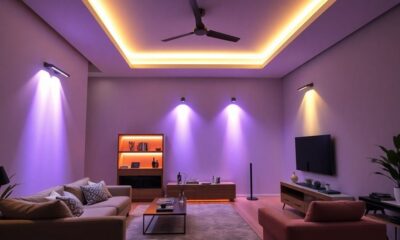Home Decor
Creative Ideas for Accent Brick Walls
Push the boundaries of traditional brick walls with innovative patterns, textures, and colors that will leave you wanting more.

You can take your accent brick wall to the next level with creative patterns, contrasting grout colors, and unique textures. Try enhancing brick shades, painting or whitewashing for a fresh look, or experimenting with lighting to highlight architectural features. Incorporate different brick sizes, colors, and patterns to add depth and character. Consider reclaimed bricks, unique mortar techniques, or statement lighting to create a one-of-a-kind design. With endless possibilities, you can craft a stunning accent wall that enhances your space. Explore these ideas further to reveal the full potential of your brick wall and discover ways to make it a true showstopper.
Key Takeaways
• Mixing brick patterns, such as running bond, herringbone, and basket weave, creates visually appealing accent walls with depth and character.
• Contrasting grout colors can enhance texture, create bold contrasts, or provide a clean, minimalist look, depending on the desired aesthetic.
• Elevating accent walls with brick pattern play, incorporating different patterns, and mixing brick sizes and colors can create a unique focal point.
• Painting or whitewashing brick walls can transform rooms, breathe new life into spaces, and customize colors to achieve a desired look.
• Experimenting with unique brick textures, such as weathered, reclaimed, or handmade bricks, can add rustic charm and visual interest to accent walls.
Brick Patterns and Designs
As you plan your accent brick wall, selecting the right pattern and design is essential for achieving the desired aesthetic, and there are several options to contemplate.
Brick patterns can greatly impact the visual interest of your wall, and choosing the right one can elevate the entire design. A classic choice is the running bond pattern, which features staggered rows of bricks that create a timeless look. This pattern is particularly effective at creating a sense of continuity and flow, making it ideal for larger accent walls.
If you want to add some visual interest, consider combining different brick patterns, such as incorporating a herringbone or basket weave design to create a unique and eye-catching accent wall. By mixing and matching different patterns, you can create a truly one-of-a-kind design that adds depth and character to your space.
With so many brick patterns to choose from, the possibilities are endless, and the right design can make all the difference in achieving the look you want.
Contrasting Grout Colors
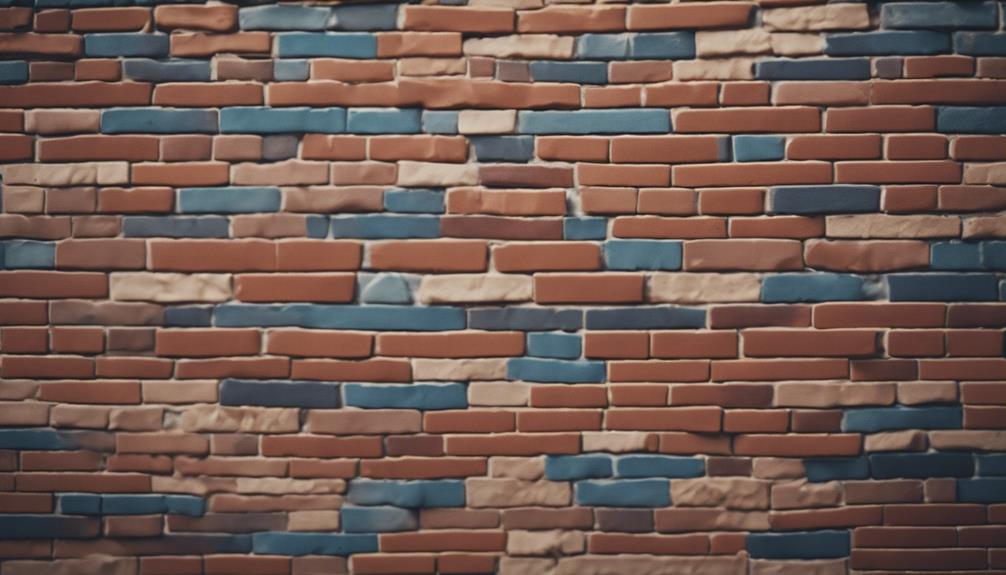
You can instantly elevate the visual appeal of your accent brick wall by carefully selecting a contrasting grout color that highlights the individual bricks and creates a striking visual impact. The right grout color can make a significant difference in the overall aesthetic of your wall paneling, accentuating the unique texture and pattern of the bricks.
| Grout Color | Effect |
|---|---|
| Darker | Enhances texture and pattern, creates a bold contrast |
| Lighter | Softens the look, creates a subtle contrast |
| Complementary | Creates a harmonious balance with the bricks' colors already |
| Neutral | Provides a clean, minimalist look |
| Bold | Adds a pop of color, creates a statement accent wall |
When choosing a grout color, consider the colors already present in the room, as well as your personal design preferences. By selecting a contrasting grout color, you can customize the appearance of your accent brick wall to fit your unique style. Remember, the choice of grout color can significantly influence the overall aesthetic of your accent brick wall, making it an important decision in your design process.
Focal Point Ideas
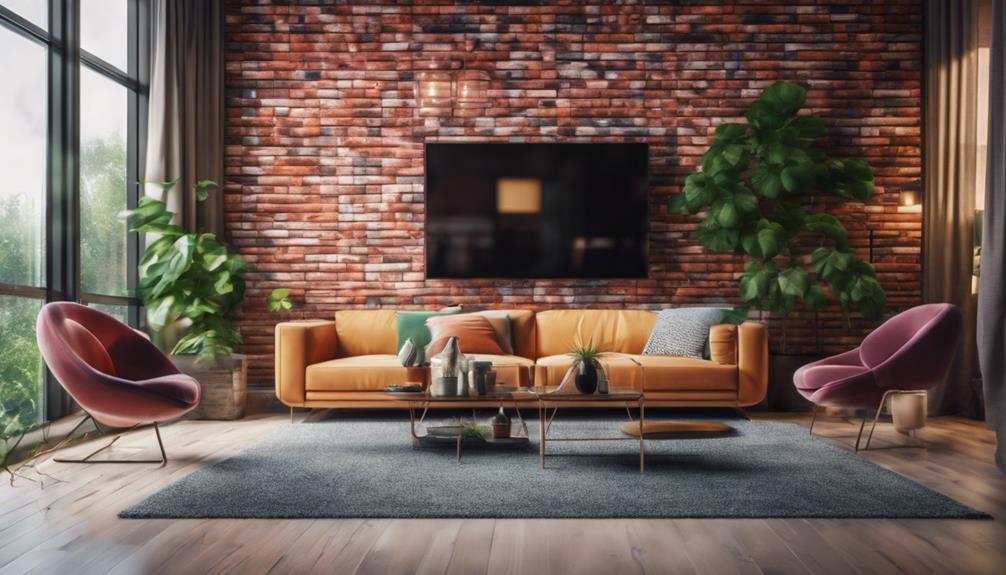
As you design your accent brick wall, you'll want to create a focal point that draws the eye and adds visual interest to the room.
Consider playing with brick patterns, such as herringbone or basketweave, to create a unique visual zone that sets your wall apart.
Brick Pattern Play
By experimenting with different brick patterns, such as herringbone, basket weave, or running bond, you can create a unique focal point that adds visual interest to your accent brick wall. Brick pattern play is an excellent way to elevate your accent wall and make it a conversation starter.
| Pattern | Description | Visual Interest |
|---|---|---|
| Herringbone | Alternating bricks in a zigzag pattern | High |
| Basket Weave | Alternating horizontal and vertical bricks | Medium |
| Running Bond | Staggered bricks in a linear pattern | Low |
To take your brick pattern play to the next level, consider combining different brick sizes and colors to add texture and visual interest. You can also incorporate an arched or curved design to highlight architectural features. Don't forget to use contrasting grout colors to make the pattern stand out even more. By experimenting with different brick patterns and techniques, you can create a one-of-a-kind accent wall that becomes the centerpiece of any room.
Visual Interest Zones
To create a visually appealing space, accent brick walls can be strategically placed to create visual interest zones that draw the eye to a specific area, such as a statement fireplace or a cozy reading nook.
By incorporating accent brick walls, you can transform a plain room into a stylish and inviting space. These walls serve as statement pieces, adding character and charm to any interior setting.
As a result, they become focal points that draw the eye, creating visual interest zones that enhance the overall interior design.
Mixing Brick Shades
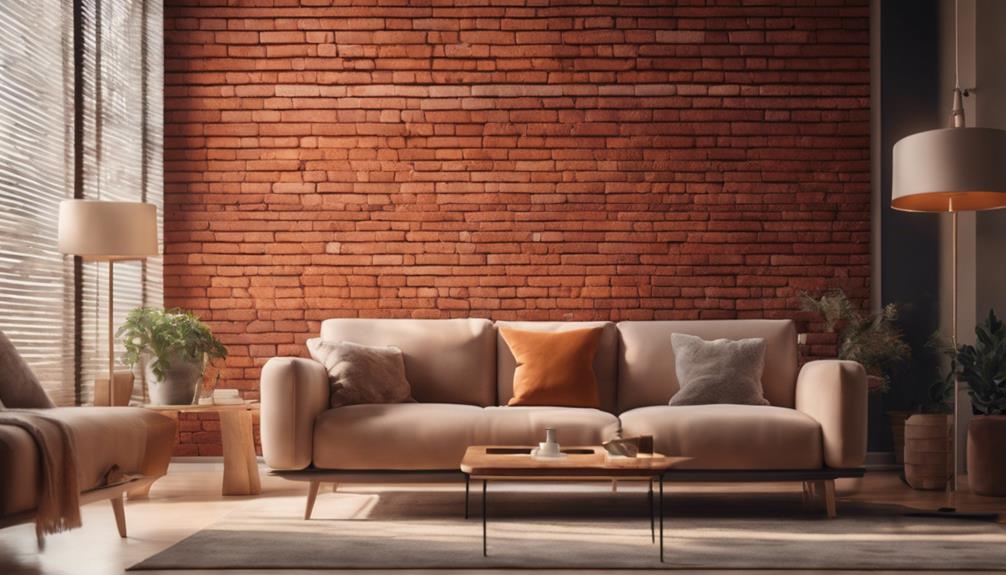
When delving into the world of mixing brick shades, you'll find that combining different hues can elevate your accent wall to the next level.
You'll need to explore brick color combinations, shade gradation techniques, and monochromatic brick schemes to create a unique look that reflects your personal style.
Brick Color Combinations
You can create a visually striking accent wall by combining different shades of brick, a technique that adds depth, contrast, and visual interest to any room.
By mixing and matching different brick colors, you can create a unique and personalized design that elevates your space. For every room, there are ideas for combining brick shades that will elevate your design to the next level.
For instance, combining light and dark brick tones adds depth and contrast to the design, while blending warm and cool brick colors creates a balanced and harmonious look. Consider experimenting with red, brown, gray, and white brick hues to find the perfect combination.
Remember to take into account the overall color scheme of the room when selecting brick shades to ensure a cohesive design. By mixing and matching different brick colors, you can create an accent wall that's truly one-of-a-kind.
Shade Gradation Techniques
By artfully blending different brick shades, you can create a stunning gradient effect that adds depth and dimension to your accent wall. Mixing brick shades for a gradient effect involves using different tones of brick to create a visually appealing shift.
By blending light and dark brick shades, you can achieve a subtle or dramatic change on your accent wall. This technique adds depth and dimension to the brick wall, enhancing the overall visual interest of the space.
Experiment with various combinations of brick shades to find the right balance and gradient effect that suits your design preferences. Shade gradation techniques can help create a unique and customized look for your accent brick wall, elevating the style of the room.
You can choose to create a gradual shift from one shade to another or opt for a more dramatic transformation, depending on your personal style. With shade gradation techniques, the possibilities are endless, and you're limited only by your imagination.
Monochromatic Brick Schemes
What makes monochromatic brick schemes so alluring is that they can elevate the aesthetic of an accent wall by layering varying shades of a single color, creating a visually appealing harmony of tone and texture.
By mixing different shades of brick, you'll add depth and visual interest to your accent wall. This design technique involves using varying tones of the same color family to create a cohesive yet dynamic look.
For instance, you could combine light, medium, and dark brick shades to achieve a harmonious balance of color and texture. The beauty of monochromatic brick schemes lies in their customizability – you can tailor the design to suit your interior style and preferences.
As light and shadow dance across the varied brick tones, the accent wall's aesthetic appeal is enhanced. By embracing the nuances of a single color, you'll create a sophisticated, harmonious look that adds character to any room.
With monochromatic brick schemes, the possibilities are endless, and the result is always striking.
Painting and Whitewashing
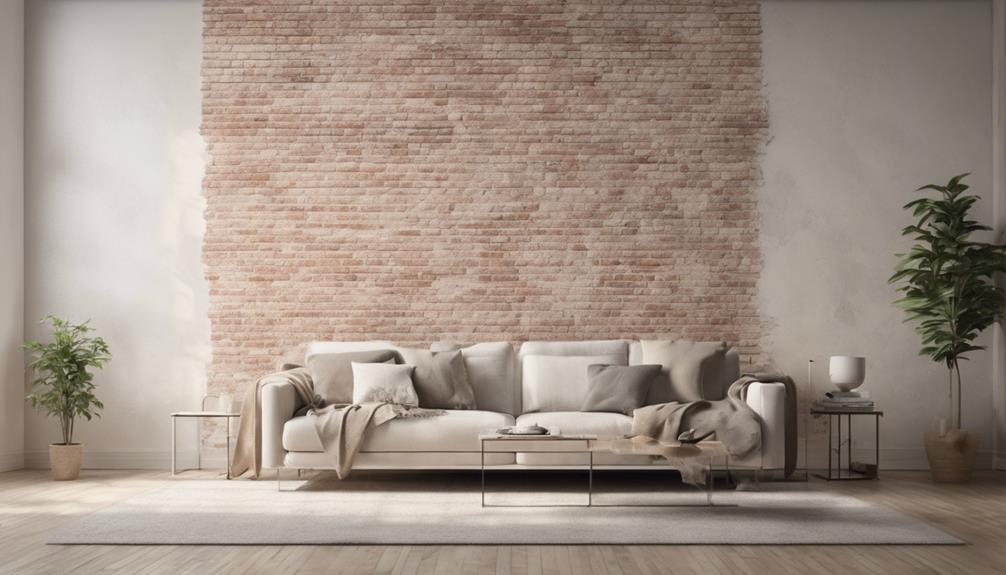
When it comes to accent brick walls, painting and whitewashing are two popular techniques that can breathe new life into an old space. You can completely transform a room by adding a fresh coat of paint or a subtle whitewash to your brick walls. Both techniques offer a unique way to enhance the texture and character of the brick.
Here are three benefits to take into account:
- Customization:
Painting brick walls allows you to choose a color that matches your design scheme, adding a pop of color or a subtle touch to the room.
- Fresh Look:
Whitewashing creates a modern and fresh look by applying a diluted paint mixture, letting some of the brick's natural color show through.
- Enhanced Texture:
Both painting and whitewashing can enhance the texture and character of brick walls, adding depth and visual interest to the space.
Lighting and Artwork Ideas
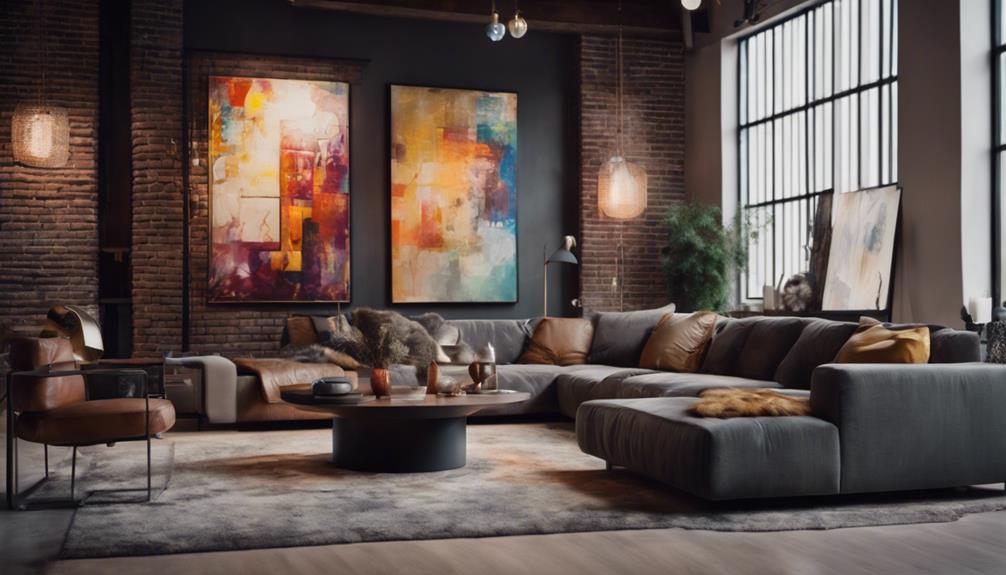
To create a visually appealing space, you can strategically use lighting to accentuate the unique texture and color variations of your brick accent wall. By incorporating wall sconces or track lighting, you can highlight the intricate details of the brick, creating a warm and inviting atmosphere.
If you're displaying artwork or photographs on your brick accent wall, consider using picture lights or gallery lighting to showcase your pieces. For a more dramatic effect, install a statement chandelier or pendant light to create a focal point against the backdrop of the brick accent wall.
You can also utilize LED strip lights or under cabinet lighting to add a warm glow and enhance the ambiance of the room. Experimenting with adjustable spotlights or recessed lighting can also create different lighting effects and shadows on the textured surface of the brick accent wall, adding depth and visual interest to your space.
Unique Brick Textures
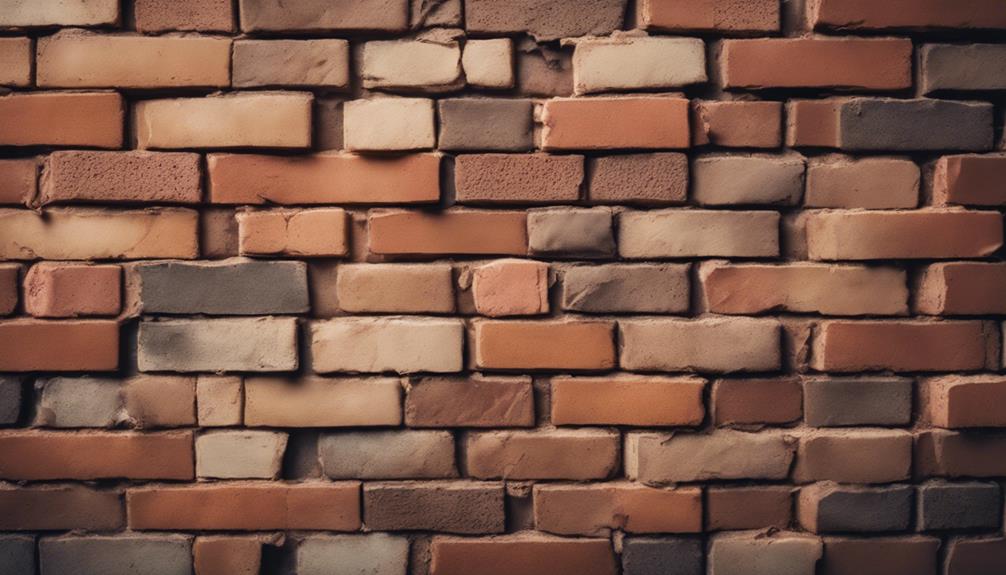
You can add depth and character to your space by incorporating brick accent walls with unique textures, such as weathered, reclaimed, or handmade bricks. These textures can create a rustic or industrial look that adds visual interest to your room.
To take your brick accent wall to the next level, consider the following techniques to enhance the texture:
- Mix and match: Combine different brick sizes, colors, and patterns to create a visually interesting textured accent wall.
- Exposed edges: Leave the brick edges rough and uneven to contribute to a raw and authentic aesthetic.
- Mortar magic: Experiment with different mortar techniques, from smooth to distressed finishes, to add an extra layer of texture to your brick wall.
Accent Wall Layouts
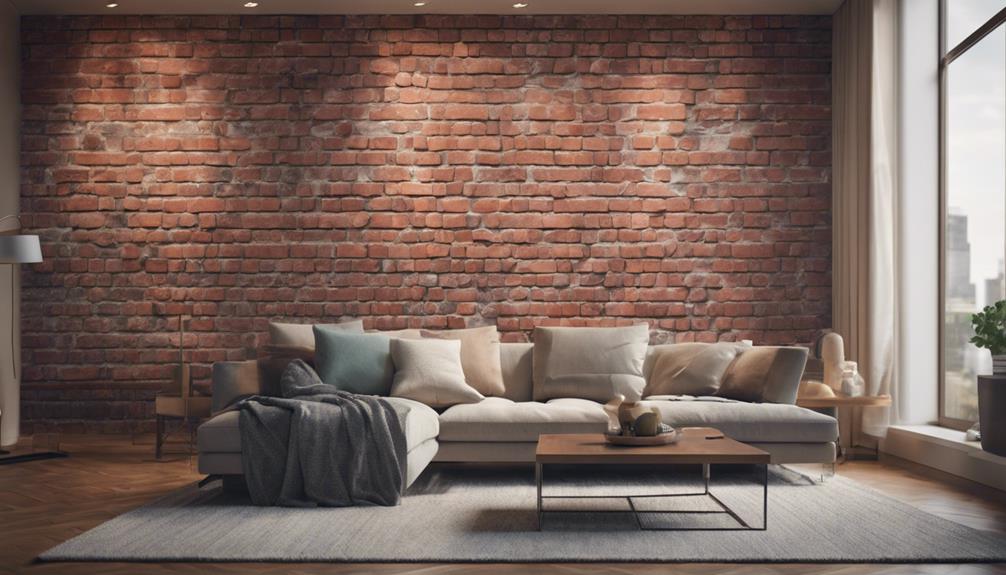
With your unique brick textures in place, it's time to arrange them in a layout that elevates your space, and that's where accent wall layouts come in.
You can create a visually striking design by choosing a layout that complements your brick texture. For instance, you can opt for a classic herringbone pattern, a modern basket weave design, or a timeless running bond layout. Mixing and matching different brick sizes and orientations can add an extra layer of visual interest to your accent wall.
Additionally, incorporating geometric shapes or patterns with bricks can give your wall a modern, artistic flair. If you want to add some eco-friendly charm to your design, consider using reclaimed or salvaged bricks.
Brick and Mortar Combinations
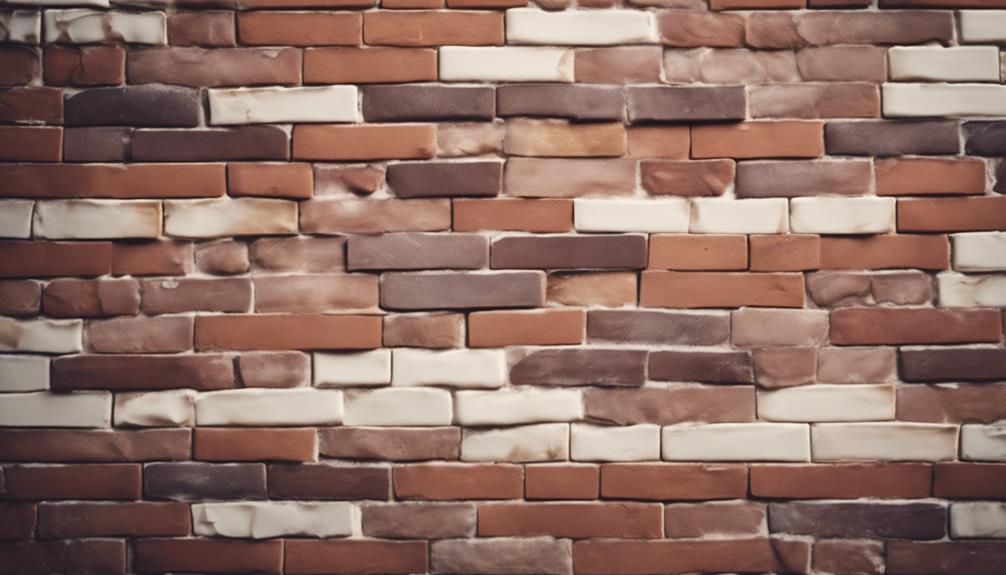
As you explore the world of brick and mortar combinations, you'll find that the possibilities are endless.
You can mix and match different brick patterns to create a unique visual identity for your accent wall, and then take it to the next level by selecting a mortar color that complements or contrasts with the brick.
With these two elements working together in harmony, you'll be able to create a one-of-a-kind design that adds depth and character to your space.
Brick Patterns Mix
By combining different brick and mortar combinations, you can create unique accent walls that reflect your personal style. Brick patterns mix is a technique that allows for creative layouts and textures on accent walls, adding visual interest and depth to the overall aesthetic of the space.
To experiment with brick patterns mix, consider the following combinations:
- Herringbone: Alternate bricks in a zigzag pattern for a dynamic look.
- Basket Weave: Alternate horizontal and vertical bricks for a woven effect.
- Running Bond: Stagger bricks in a linear pattern for a classic, timeless look.
Mortar Color Options
You can dramatically alter the appearance of your accent brick wall by selecting a mortar color that complements or contrasts with your brick choice. The right mortar color can elevate the overall aesthetic of your design, so it's essential to choose wisely.
Traditional gray mortar provides a classic, timeless look, while white mortar gives a modern and clean appearance. If you want to create a bold statement, consider a contrasting mortar color that makes the bricks stand out.
On the other hand, you can opt for a custom mortar color that blends seamlessly with your brick choice, creating a cohesive look. Alternatively, you can choose a custom color that adds a unique touch to your design.
Whatever you decide, remember that the mortar color should complement the brick color and style of the space, enhancing the overall design impact of your accent brick wall. By selecting the right mortar color, you can take your design to the next level and create a stunning visual effect.
Decorative Brick Accents
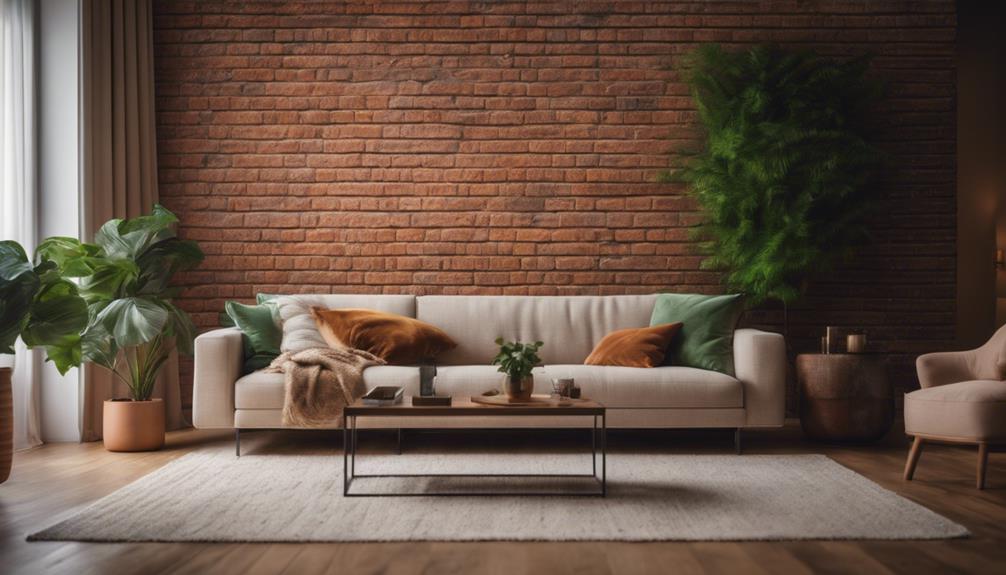
Add a touch of rustic charm to your space with decorative brick accents, which bring texture and character to any room. These accents not only add visual appeal but also create a sense of warmth and coziness.
Whether you're looking to add a statement wall, accentuate a fireplace, or create a unique backsplash, decorative brick accents are a great way to do so.
Here are just a few ways to incorporate decorative brick accents into your design:
- Accent Walls: Create a focal point in your room with a decorative brick accent wall that adds texture and visual interest.
- Fireplace Surrounds: Add a touch of rustic charm to your fireplace with a decorative brick surround that complements your mantel and hearth.
- Backsplashes: Protect your walls from splashes and stains while adding a decorative touch with a brick accent backsplash.
Frequently Asked Questions
How to Decorate a Brick Accent Wall?
When decorating a brick accent wall, you'll want to create a cohesive look that showcases its unique texture.
Start by incorporating lighting fixtures that highlight the brick's natural beauty.
Next, balance the industrial feel with modern furniture and indoor plants.
Make sure the room's color scheme complements the brick's tone to avoid visual clashes.
How Do You Make a Brick Wall Interesting?
You'd think a brick wall would be, well, boring, but surprisingly, it's a blank canvas waiting for your creative touch.
To make a brick wall interesting, try adding unexpected elements like sconces, floating shelves, or a statement piece of furniture.
You can also experiment with paint techniques, like color washing or stenciling, to add visual interest.
What Art Looks Good on a Brick Wall?
When it comes to choosing art for a brick wall, you'll want pieces that create a striking contrast with the rustic texture. Consider large-scale abstract art or modern pieces with vibrant colors to pop against the earthy tones of the brick.
You can also opt for metal or industrial-themed art to complement the raw feel of the wall. Whatever you choose, make sure it's large enough to make a statement and create a dynamic look.
How to Modernise Interior Brick Walls?
To modernize your interior brick walls, you'll want to create a sleek, contemporary look. Start by painting the walls with light, neutral colors like white or grey, which will instantly brighten up the space.
Then, incorporate modern furniture and decor with clean lines and minimalist designs to contrast the rustic texture of the brick.
Conclusion
As you've explored the world of creative ideas for accent brick walls, you've only scratched the surface of what's possible. You've seen the power of patterns, colors, and textures, but there's more to uncover.
The next great design is waiting to be discovered, and it's up to you to push the boundaries of what's been done before. Will you combine contrasting grout colors with unique textures, or will you venture into uncharted territory?
The possibilities are endless, and the only limit is your imagination.
Vivienne – Your Content Companion Vivienne is your content companion, curating valuable tips, advice, and inspiration to guide you on your home decor journey. From insightful blog posts to informative product descriptions, she’s here to empower you with the knowledge you need to create your dream space.
Home Decor
Maximalist Decor: How to Do It Right
Curate your space with bold colors and textures to achieve stunning maximalist decor; discover essential tips for perfecting this vibrant aesthetic.
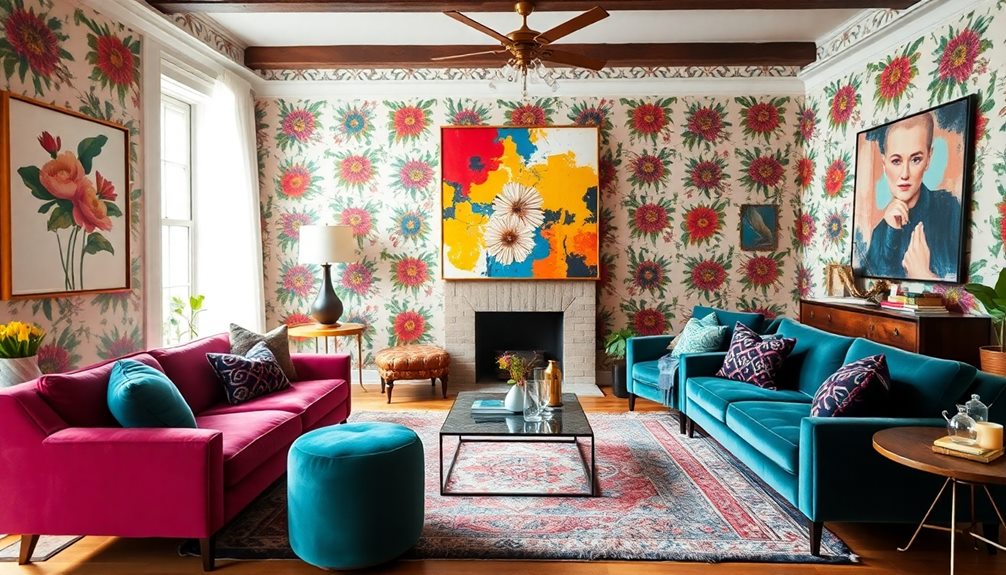
Maximalist decor is all about embracing bold expression and eclectic styles to create a unique space. Start with a cohesive color palette of 3-5 main colors to unify your design. Layer different textures, including fabrics like velvet and silk, to add depth and richness. Mix patterns—big with small—while maintaining color harmony to avoid chaos. Group collections of items in odd numbers for visual interest, and don't shy away from using negative space to balance boldness. With careful planning, your space will feel vibrant and personalized. There's more to explore for achieving this stunning aesthetic.
Key Takeaways
- Establish a cohesive color palette of 3-5 main colors to unify diverse decor elements while allowing for bold contrasts.
- Layer various textures, such as velvet and silk, to create richness and visual interest in your space.
- Mix patterns thoughtfully, balancing bold designs with subtler ones to enhance visual complexity without overwhelming the room.
- Curate personal collections by grouping similar items in clusters of three or five for impactful and dynamic displays.
- Utilize negative space effectively to prevent clutter and allow bold decor choices to stand out beautifully.
Defining Maximalism in Decor
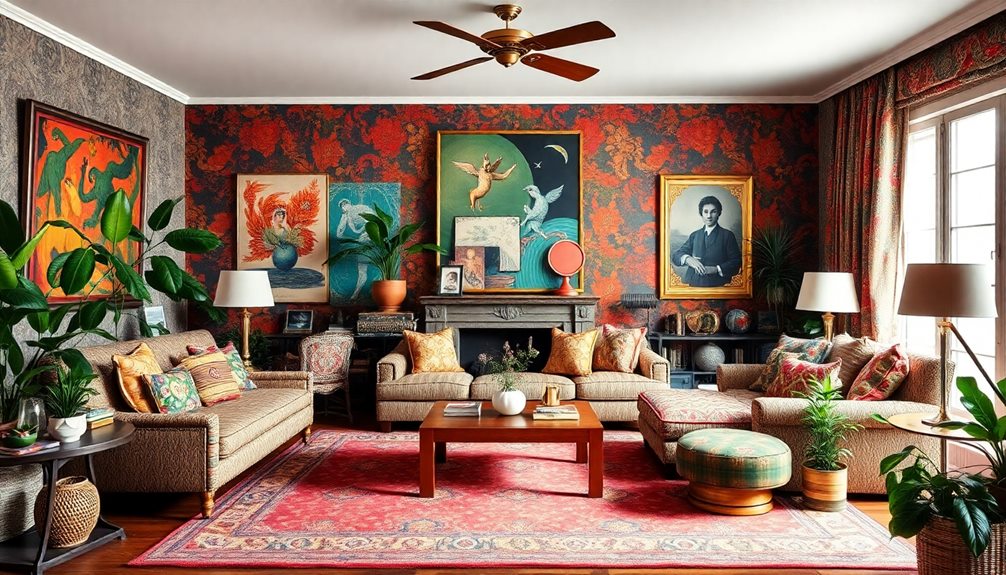
Maximalism in decor isn't just about filling a space; it's a vibrant celebration of personal expression and individuality. This approach to interior design thrives on the idea that "more is more," allowing you to showcase your unique tastes through an eclectic mix of colors, patterns, and decorative items.
In a maximalist living room, you might layer bold textiles, incorporate a variety of textures, and display cherished collections—all elements that reflect your personal style.
Incorporating elements from different cultural styles, such as traditional Indonesian style home decor, can enhance your maximalist aesthetic by adding depth and richness.
A cohesive color palette is vital in maximalist design. It unifies diverse elements, creating harmony amid the vibrant chaos. You can choose a bold, rich palette that resonates with your personality, ensuring that even the busiest patterns feel intentional.
Imagine a space filled with daring prints, from floral to geometric, each serving as a backdrop for your artistic expression.
Key Elements of Maximalist Design

When you're embracing maximalist design, start by focusing on color cohesion strategies that unify your space while allowing for bold contrasts.
Layering textures effectively is equally important; mixing materials like velvet, silk, and leather can create a rich, inviting atmosphere.
Together, these elements make your decor feel dynamic and personalized.
Color Cohesion Strategies
Establishing a cohesive color palette is essential for achieving a harmonious maximalist design. Start by selecting 3-5 main colors that reflect the desired mood of your space. Confirm that each piece of furniture, artwork, and accessory complements this cohesive scheme.
To create a sense of unity, repeat these colors across different rooms, making your home feel interconnected and inviting.
Don't shy away from bold hues like cobalt blue or blush pink; these can function as neutral tones, enhancing versatility while keeping your aesthetic intact. Incorporate varying shades of the same color in different patterns and textures to add depth, confirming you remain within your overall color palette.
Balancing vibrant colors with neutral bases—think white or beige walls and large furnishings—provides visual breaks and prevents the space from feeling overwhelming. This strategy allows the bold colors to pop without clashing.
Layering Textures Effectively
Layering textures effectively transforms a space into a rich tapestry of visual and tactile experiences. By mixing materials like velvet, silk, leather, and cotton, you create depth and visual interest.
Start by incorporating various textiles through rugs, cushions, and throws to enhance comfort and warmth, providing a rich tactile experience.
It's essential to focus on balancing textures. Pair heavier materials, like thick wool or plush upholstery, with lighter options, such as linen or sheer fabrics. This balance prevents overwhelming the design while maintaining visual harmony.
To create a striking focal point, strategically layer textures. For example, combine a bold patterned sofa with a contrasting textured throw; this draws attention and enhances the overall aesthetic.
Don't shy away from experimenting with the scale of textures, either. Make sure that large, dominant patterns are balanced by smaller, subtler textures to avoid visual chaos and keep the composition engaging.
Incorporating these layering techniques will elevate your maximalist decor, making your space feel both inviting and dynamic. Embrace the beauty of textures, and watch your design come to life!
Practical Tips for Maximalism
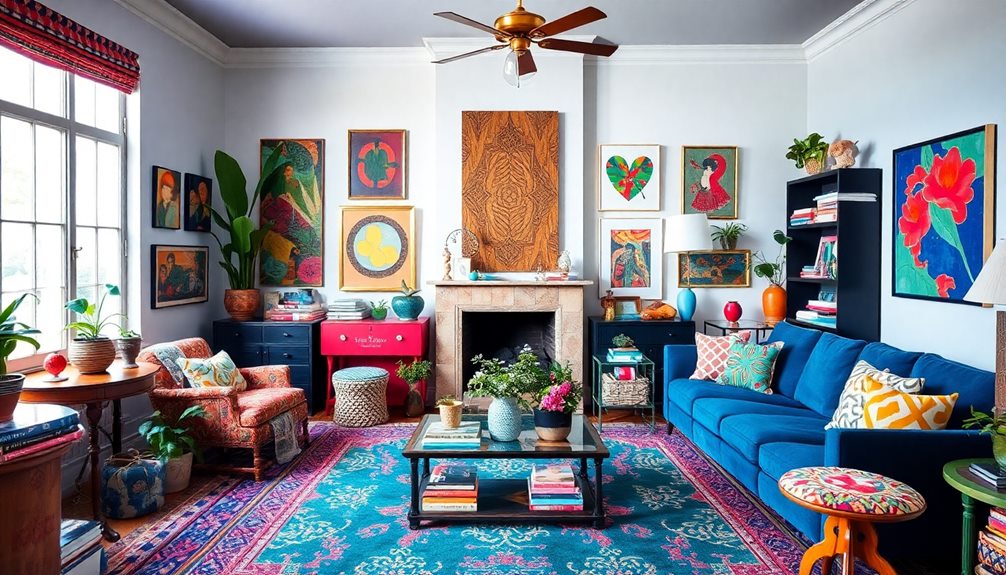
To create a stunning maximalist space, start with a neutral foundation that sets the stage for bold patterns and vibrant colors. Using a tone-on-tone palette or solid colors allows you to mix prints without overwhelming your interior.
Consider incorporating elements that enhance creating seamless indoor-outdoor flow to bring a harmonious connection between spaces. Choose a cohesive color palette that harmonizes across your furnishings, fabrics, and artwork to maintain unity throughout the room.
When it comes to decor, group similar items in clusters of three or five. This tip enhances visual strength and creates impactful focal points that draw the eye.
Don't shy away from incorporating a variety of textures and materials, like velvet, leather, and natural fibers, to add depth and richness to your maximalist design.
Embrace negative space by allowing select objects to breathe. This prevents visual clutter and enhances the overall aesthetic of your space.
Balancing Color and Texture
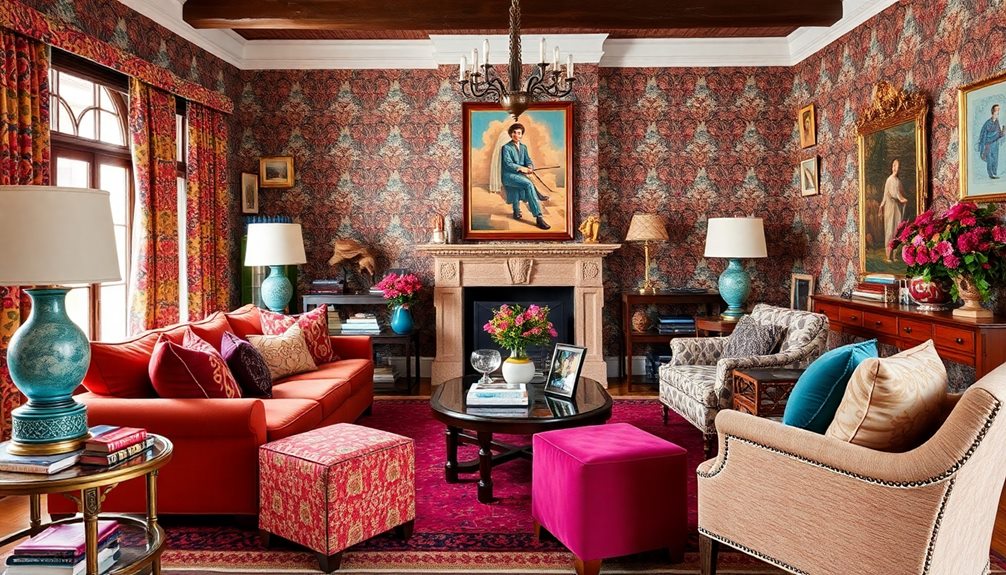
To create a truly stunning maximalist space, you'll want to harmonize bold colors while layering textures intentionally.
Mixing patterns effectively can elevate your design, adding complexity without chaos.
Harmonize Bold Colors
Maximalist decor thrives on the vibrant interplay of colors and textures, creating spaces that are both stimulating and inviting. To harmonize bold colors, you should start with a cohesive color palette that mixes bold hues with softer shades. This approach not only embraces the maximalist aesthetic but also helps maintain visual harmony.
Don't forget to incorporate accent colors; they can link various elements in your room, ensuring that your vibrant pieces coexist without clashing. For instance, cobalt blue and blush pink can serve as neutral tones amidst the bold colors.
Repeating certain hues across decor items—think artwork, cushions, and furniture—fosters a sense of unity throughout the space. This repetition is key in creating that fluid connection you're after.
Additionally, effectively utilizing negative space will allow your bold colors to stand out, preventing the room from feeling overwhelming. Instead of clutter, aim for a balanced look that celebrates the "more is more" philosophy of maximalism.
Layer Textures Intentionally
In a well-designed maximalist space, layering textures intentionally makes all the difference. It adds depth and richness, creating a cozy atmosphere that invites you in.
By thoughtfully combining materials, you can enhance visual intrigue while ensuring a cohesive mix that unifies diverse elements. For instance, incorporating elements from Boho Chic Bedroom Decor can introduce eclectic patterns and soft fabrics that elevate comfort.
Here's how to layer textures effectively:
- Combine Soft and Hard: Pair soft textiles like velvet and silk with harder surfaces such as glass or metal to create dynamic contrast.
- Incorporate Varied Materials: Use a mix of leather, wood, and metals to enrich your decor and add interest.
- Repeat Textures for Cohesion: Introduce certain textures throughout the space to maintain a sense of flow and harmony.
- Strategic Patterns: When using patterns, balance bold prints with subtler designs to avoid visual chaos, keeping things engaging yet manageable.
Mix Patterns Effectively
Mixing patterns effectively can transform a space from ordinary to extraordinary, adding vibrancy and character. To achieve this in your maximalist style, start by considering the scale of the patterns you choose.
Use smaller patterns in confined areas and larger ones in expansive spaces to maintain visual balance. A cohesive color palette is essential; it unites all patterns, preventing chaos while enhancing harmony.
Don't overlook texture—combine materials like velvet, linen, and silk to add depth and interest. Ascertain these textures complement each other visually.
Group your favorite things by theme or color; for instance, floral prints can be paired with geometric designs if they share a common color scheme.
Curating Personal Collections
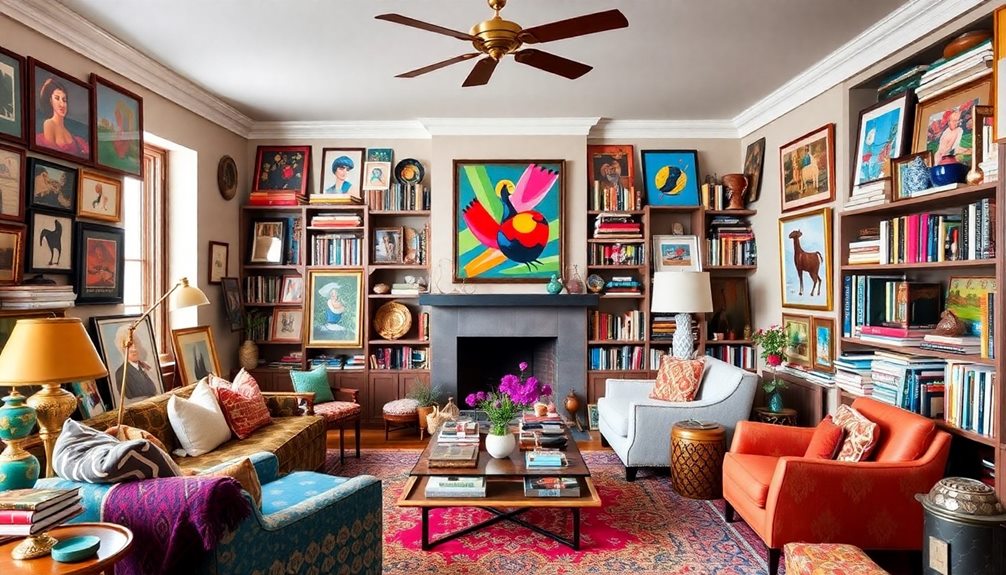
Curating personal collections in your home is an opportunity to tell your unique story through decor. Maximalism design invites you to showcase items you love, celebrating their significance while creating a cohesive aesthetic.
To effectively curate your collections, consider these ideas:
- Group Similar Items: Arrange vases, books, or art pieces together to enhance visual strength. Aim for arrangements of three or five for maximum impact.
- Embrace Varied Heights: Use staggered arrangements and varied heights in your displays. This adds dynamic composition and avoids boring uniform lines.
- Incorporate Meaningful Displays: Include curated pieces like travel souvenirs or inherited heirlooms, emphasizing the stories behind each item. This enhances storytelling through decor.
- Gradual Addition: Focus on curating collections over time. Add meaningful items gradually to maintain an eclectic yet cohesive look that reflects your personality.
Maximizing Space and Light
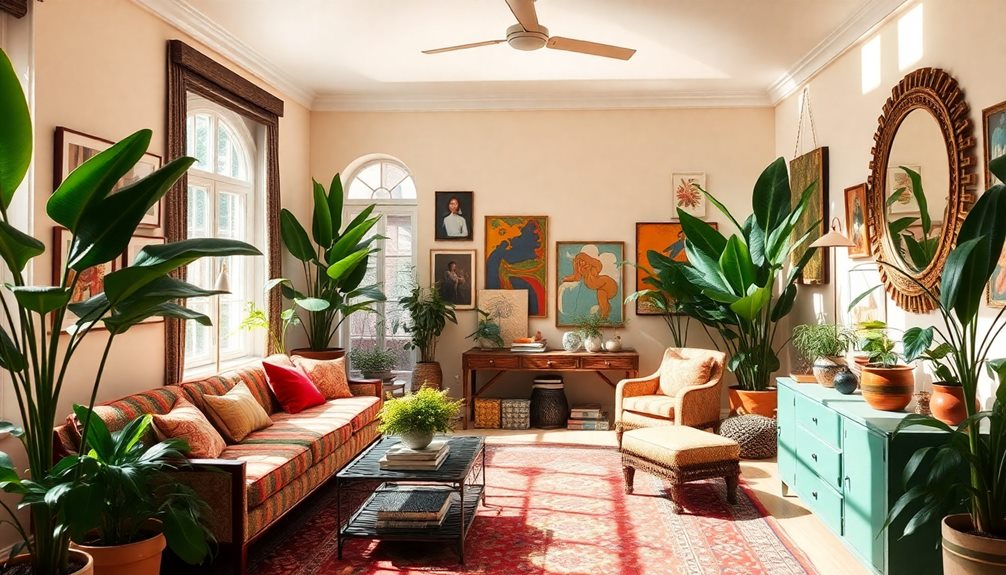
Maximalist decor can sometimes feel overwhelming, but with the right strategies, you can create a space that feels open and inviting.
Start by utilizing vertical surfaces; installing shelves and hanging art keeps your floor space open and visually accessible. This allows you to showcase your collections without cluttering the area.
Incorporate mirrors strategically to enhance the overall brightness of your maximalist interior. They create the illusion of more space while reflecting light, making your room feel airy and expansive.
Choosing multifunctional furniture is another smart move. Opt for ottomans with storage or coffee tables that double as workspaces, helping you maintain functionality without overcrowding.
Light-colored walls or large windows invite natural light, balancing the bold colors and patterns typical of maximalist design. This not only brightens the room but also makes it feel larger.
Frequently Asked Questions
How to Start Maximalist Decor?
To start maximalist decor, you'll want to establish a neutral base first. Then, choose a cohesive color palette, embrace bold statement pieces, and layer your decor gradually while balancing negative space for visual interest.
How to Do Maximalism Right?
Mastering maximalism's vibrant dance means weaving bold colors, cherished treasures, and harmonious patterns. You'll breathe life into your space by layering textures, balancing elements, and embracing negative space, creating an inviting, eclectic masterpiece that tells your story.
What Are the Principles of Maximalist?
When exploring maximalism, focus on bold colors and patterns, layer various textures, curate collections, and balance visual weight. These principles help you create engaging, personalized spaces that reflect your unique style and story.
How to Be a Maximalist Without Clutter?
To be a maximalist without clutter, start with a neutral base, curate meaningful items, and strategically place decor. Embrace negative space and use stylish storage solutions to keep essentials accessible yet visually harmonious.
Conclusion
Embracing maximalist decor is like painting your life with vibrant strokes, each color telling a story. By layering textures and curating cherished collections, you create a sanctuary that reflects your soul. Don't shy away from bold choices; instead, let them dance together, igniting joy in every corner. Remember, your space should feel like an embrace—a mosaic of memories and dreams. So go ahead, release your creativity, and transform your home into a vivid tapestry of who you truly are.
Xavier – Your Operations Partner Xavier is your operations partner, working tirelessly behind the scenes to ensure that everything runs smoothly so you can enjoy a seamless experience with Perfect Fit Living. From managing inventory to coordinating logistics, he’s committed to making your experience with us hassle-free.
Home Decor
Indoor Plant Styling: From Floor to Ceiling
Transform your space with indoor plant styling techniques that enhance beauty and air quality—discover the secrets to creating your lush oasis.
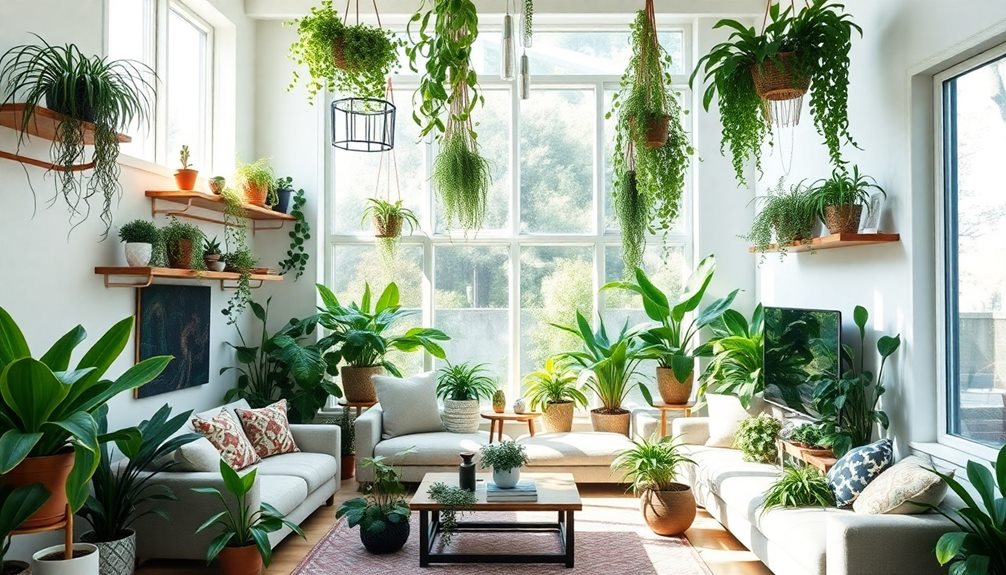
Indoor plant styling can elevate your space, enhancing both beauty and air quality from floor to ceiling. Start by evaluating your light conditions and choosing the right plants that fit your room. Use creative display ideas, like wall-mounted planters and hanging plants, to maximize your vertical space. To personalize your style, mix unique pots and group plants in odd numbers for balance. Regular care, such as checking soil moisture and dusting leaves, will keep your plants thriving. Ready to transform your home into a lush oasis? There's plenty more to discover that can elevate your plant game even further!
Key Takeaways
- Utilize wall-mounted planters and shelves to maximize vertical space and showcase plants without cluttering the floor.
- Incorporate hanging plants to draw the eye upward, enhancing spatial perception and adding visual interest.
- Select decorative pots that align with your room's decor style for a cohesive aesthetic throughout the space.
- Group plants in odd numbers for balance and visual appeal, creating harmonious arrangements across different heights.
- Mix various plant species with unique shapes and textures to enhance dynamism and interest from floor to ceiling.
Benefits of Houseplants

When you bring houseplants into your home, you're not just adding a touch of greenery; you're also reaping a multitude of benefits. One of the most significant advantages of houseplants is their ability to improve air quality. They filter out toxins like formaldehyde and benzene, enhancing your overall indoor health.
Additionally, certain houseplants are known to help reduce stress levels, making them a great addition to any home environment.
Furthermore, indoor plants can dramatically reduce stress levels. Studies show that having plants around can lower blood pressure and heart rate, leading to a more relaxed atmosphere.
With increased humidity from your plants, you'll also notice improvements in skin health and respiratory function, especially in dry environments.
Moreover, if you work from home, incorporating greenery in your workspace can boost productivity and concentration by as much as 15%. This simple addition to your home decor promotes a sense of well-being and connection to nature, which is linked to better mental health outcomes.
In short, the benefits of houseplants extend far beyond aesthetics. By choosing to include indoor plants in your living space, you're making a positive impact on your health and overall happiness.
Choosing the Right Plants

When you're choosing the right indoor plants, start by evaluating the light conditions in your space to find plants that thrive in those settings.
Next, think about the size of your area and how larger plants can make a statement versus how smaller ones can fit on shelves.
If you have pets, guarantee you pick non-toxic options to keep everyone safe while enhancing your home.
Assessing Light Conditions
Evaluating light conditions is often the most important step before choosing indoor plants. Understanding how light levels vary in your space helps guarantee your plants thrive.
Here's a quick guide to evaluating light conditions:
- Identify Direct vs. Indirect Light: Direct sunlight means at least 6 hours of bright light daily, while indirect light occurs in filtered spaces.
- Monitor Seasonal Changes: Light availability changes with the seasons. Keep an eye on how your plants respond throughout the year.
- Use a Light Meter: To get precise readings, consider using a light meter. This tool helps you measure the intensity of light in different areas.
- Observe Window Placement: Note how light enters through windows. South-facing windows receive the most light, while north-facing ones get less.
Plant Size Considerations
Selecting the right plants for your indoor space involves considering both the size of your room and the scale of your furniture. When you think about plant size considerations, larger plants like fiddle leaf figs can make a statement in spacious areas, while smaller plants such as succulents fit better in compact spaces.
Larger plants generally need more water due to their increased leaf surface area, making proper watering techniques vital for keeping them healthy. Aim for at least 6-8 inches of clearance around larger plants to guarantee airflow and prevent mold or disease.
To create visually appealing arrangements, group your plants in odd numbers, like three or five. This approach draws the eye and maintains balance in your decor.
Position tall plants in corners or next to large furniture pieces to anchor the space and avoid clutter. Smaller plants can easily find their home on shelves or tabletops, maximizing your use of space and time.
Pet-Friendly Options
Creating a vibrant indoor space while ensuring your pets are safe requires careful plant selection. You want to choose pet-friendly plants that enhance your home without putting your furry friends at risk.
Selecting plants can be similar to choosing eco-friendly toys for children, as both involve prioritizing safety and well-being. Here are four great options to take into account:
- Spider Plant: Known for its air-purifying qualities, this plant is non-toxic to both cats and dogs.
- Boston Fern: This lush, green option adds a touch of elegance and is safe for your pets.
- Parlor Palm: An excellent choice for low-light areas, this palm not only looks good but is also non-toxic.
- Bamboo Palm: With its tropical vibe, this palm improves air quality and is safe for your pets.
The American Society for the Prevention of Cruelty to Animals (ASPCA) offers a detailed list to help you identify toxic and non-toxic plants.
Remember, even pet-friendly plants can cause mild gastrointestinal upset if ingested in large quantities, so keep an eye on your pets' behavior around them.
Creative Display Ideas
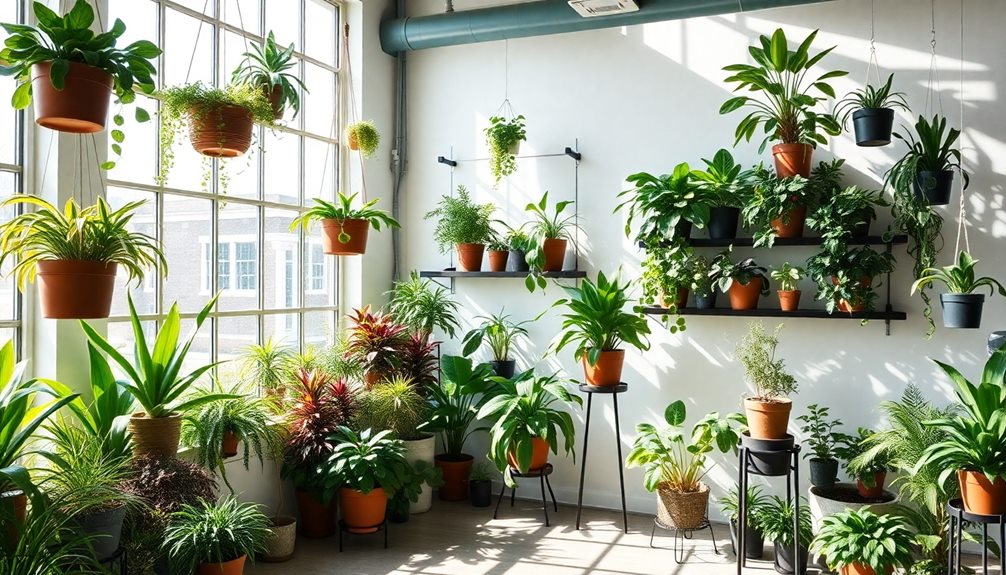
When it comes to displaying your plants, think vertically to maximize your space and create an eye-catching wall of greenery.
Unique containers, like repurposed jars or quirky pottery, can add personality and spark conversation.
Vertical Space Utilization
Maximizing vertical space is essential for transforming any indoor area into a vibrant sanctuary filled with greenery. You can creatively display your humble houseplants while ensuring your space feels open and inviting.
Here are some effective ideas:
- Wall-Mounted Planters: Utilize wall-mounted planters to showcase a variety of plants without sacrificing floor space. They create a stunning visual effect and can be arranged in patterns for added flair.
- Hanging Plants: Use plant hangers to suspend plants from ceilings or high shelves. This technique draws the eye upward, enhancing the sense of space and adding depth to your decor.
- Tiered Plant Stands: Incorporate tiered plant stands or ladders to arrange your plants at different heights. This not only maximizes light exposure but also makes it easier to care for your plants.
- Vertical Gardens: Consider creating a vertical garden or living wall. This bold design statement can transform a small area into a lush oasis while improving air quality.
Unique Container Ideas
Transforming your indoor space can be as simple as choosing the right containers for your plants. Unique container ideas can elevate your decor while showcasing your greenery. One way to achieve this is through upcycling everyday items like mason jars, tin cans, and wooden crates. These personalized plant containers not only add character but are also environmentally friendly.
Consider using decorative baskets for your potted plants. They add texture and make it easy to rearrange your space as needed. For a modern twist, incorporate terrariums made from glass containers. These eye-catching displays can create miniature ecosystems that draw attention.
Hanging planters crafted from macramé or repurposed materials can bring vertical interest to your home, especially in limited spaces. This allows your plants to thrive while creating a dynamic aesthetic.
Finally, think about integrating furniture with built-in planters, such as coffee tables or shelving units. This combination of functionality and style helps you utilize space effectively while showcasing your plants beautifully.
With these unique container ideas, you can transform your indoor environment into a lush oasis.
Vertical Space Utilization
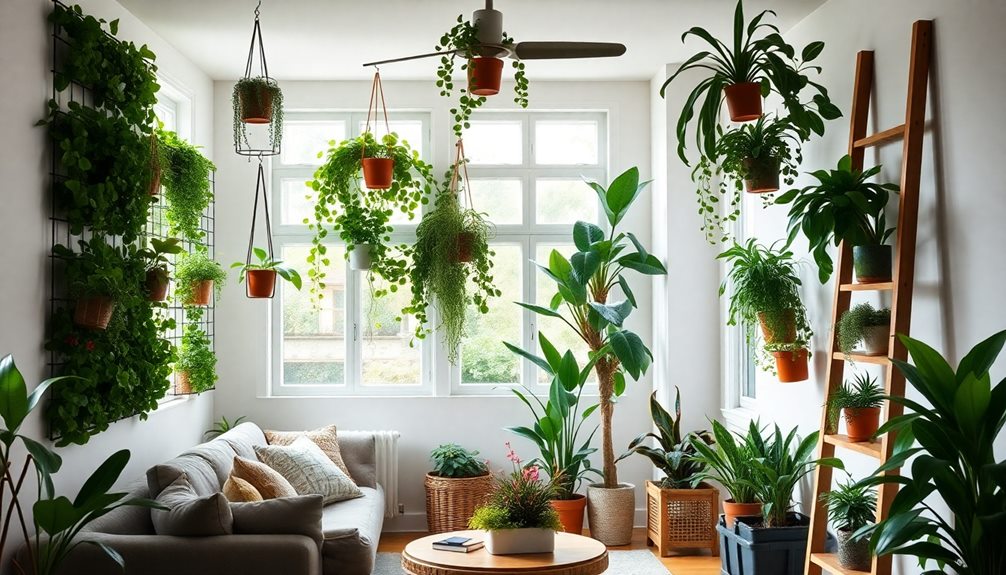
In recent years, utilizing vertical space in your home has become an essential strategy for adding greenery without cluttering your floors.
By incorporating plants in innovative ways, you can enhance the aesthetic of small rooms while also enjoying health benefits. Here are some effective methods to maximize vertical space:
- Wall-Mounted Planters: Install these to create stunning green accents on your walls. They're perfect for small spaces and can add a pop of color.
- Hanging Plants: Suspend plants from ceilings or walls to draw the eye upward. This not only creates dynamic visual interest but also makes your space feel larger and more open.
- Vertical Gardens: Consider a living wall to improve air quality and humidity while serving as a striking decor piece.
- Trellises for Climbing Plants: Use trellises or plant stands to support climbing plants, transforming bare walls into lush displays.
Indoor Plant Decor Trends
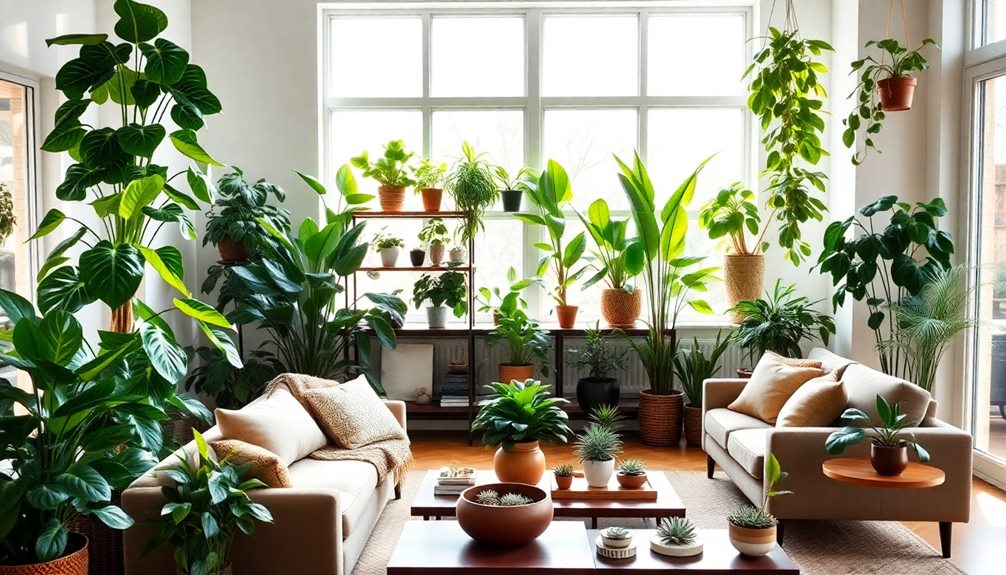
As you elevate your indoor plant game with vertical space utilization, it's also important to stay updated on the latest decor trends shaping how we incorporate greenery into our homes. A significant 70% of homeowners agree that indoor plant decor enhances their living spaces and overall ambiance.
Biophilic design principles are gaining popularity, emphasizing our connection to nature and inspiring urban jungle aesthetics that bring the outdoors inside.
DIY terrariums and vertical gardens are now trendy, allowing you to showcase your unique style while maximizing your space. These creative options not only look stunning but also make a statement about your personality and passion for plants.
Moreover, there's a surge in demand for rare and exotic houseplants, with online searches for unique species rising by 50% over the past year. This reflects a growing desire for distinctive indoor greenery that sets your space apart.
Finally, sustainable decor practices are on the rise, as 45% of consumers prefer upcycled planters and organic plant care products, aligning with the movement toward environmentally conscious living.
Embrace these trends to create a lush, inviting atmosphere in your home.
Care and Maintenance Tips

Caring for your indoor plants is essential to guaranteeing they thrive and enhance your living space. With the right care and maintenance, you can create an environment where your plants flourish. Here are some tips to keep in mind:
- Watering: Establish a consistent watering schedule by checking the top inch of soil for dryness. Most houseplants prefer to dry out slightly between waterings to prevent root rot.
- Soil: Use a well-draining potting mix tailored to your plant's needs. This guarantees adequate drainage and supports healthy root development.
- Dusting: Regularly dust the leaves with a damp cloth. This enhances photosynthesis and maintains plant health by preventing dust from hindering light absorption.
- Pruning: Prune dead or yellowing leaves as needed. This not only encourages new growth but also helps maintain a tidy appearance and prevents potential pest infestations.
Additionally, monitor light conditions and adjust plant placement accordingly.
Rotating your plants periodically will guarantee they receive even light exposure, promoting balanced growth.
With these simple steps, your indoor plants will thrive and bring life to your space.
Personalizing Your Plant Style
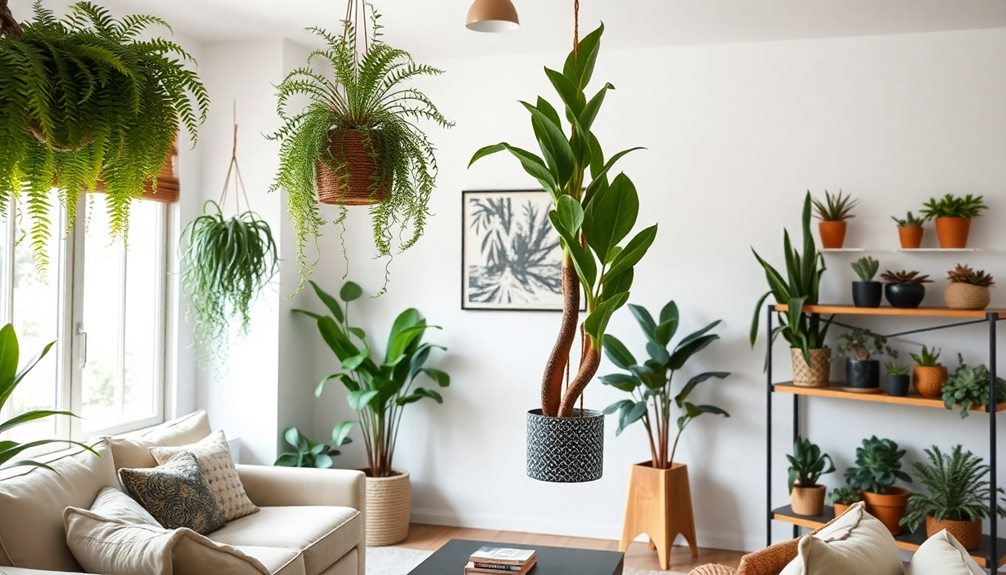
Transforming your indoor space with plants goes beyond simply choosing greenery; it's about expressing your personal style. Start by selecting species that resonate with you. For instance, spiky succulents offer a modern aesthetic, while lush ferns can create a tropical vibe. Mixing various leaf shapes and textures enhances visual interest, making your space more dynamic.
To elevate your plant displays, consider decorative pots that align with your room's color scheme. Modern geometric designs can complement contemporary decor, while rustic terra-cotta pots add a touch of warmth. Grouping plants in odd numbers—like three or five—creates a balanced arrangement that draws the eye.
Incorporating personal touches, such as handmade macramé hangers or repurposed vintage containers, allows for unique expressions of your style. Here's a quick reference to help you personalize your plant style:
| Plant Type | Aesthetic | Decorative Pot Style |
|---|---|---|
| Spiky Succulents | Modern | Geometric |
| Lush Ferns | Tropical | Rustic Terra-Cotta |
| Colorful Blooms | Bohemian | Vintage |
| Air Plants | Minimalist | Hanging Macramé |
Frequently Asked Questions
How Do I Safely Hang Plants From the Ceiling?
To safely hang plants from the ceiling, choose lightweight pots, use sturdy hooks, and guarantee they're anchored properly. Measure the height for ideal light, and regularly check for stability and moisture to avoid accidents.
What Are the Best Pots for Indoor Plant Styling?
When choosing pots for your indoor plants, consider materials like ceramic or terracotta for aesthetics and drainage. You'll want sizes that fit your plants comfortably, ensuring they have room to grow and thrive.
Can Indoor Plants Improve Air Quality Effectively?
You've probably heard that indoor plants can freshen up your space. It's true! They absorb toxins and release oxygen, effectively improving air quality. Just think of them as your little green air-purifying superheroes!
How Often Should I Rotate My Indoor Plants?
You should rotate your indoor plants every couple of weeks. This helps them grow evenly, preventing them from leaning toward light sources. Regularly changing their position keeps them healthy and vibrant throughout the year.
Are There Specific Plants That Thrive in Low Light?
When it comes to low light, you're in luck! Snake plants, pothos, and ZZ plants thrive beautifully. They're perfect choices, letting you enjoy greenery even in those not-so-sunny spots of your home.
Conclusion
As you fill your space with lush greenery, picture each plant as a vibrant brushstroke on the canvas of your home. From the cascading ivy draping elegantly from shelves to the tall, proud monstera reaching for the light, each choice elevates your environment. Embrace the joy of nurturing these living pieces of art, and let your indoor garden bloom into a personal sanctuary, where every leaf whispers stories of growth and tranquility. Your home deserves this touch of nature.
Xavier – Your Operations Partner Xavier is your operations partner, working tirelessly behind the scenes to ensure that everything runs smoothly so you can enjoy a seamless experience with Perfect Fit Living. From managing inventory to coordinating logistics, he’s committed to making your experience with us hassle-free.
Home Decor
Creating an Aesthetic Home Office Space
Keep your creativity flowing by crafting an aesthetic home office space that inspires productivity and comfort—discover how to transform your workspace!
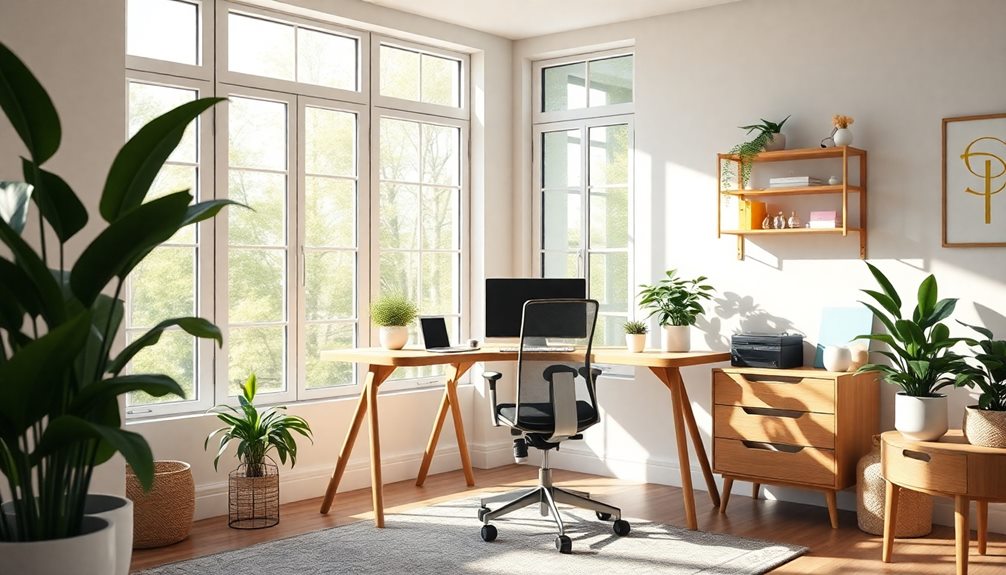
Creating an aesthetic home office space transforms your work environment into a haven of inspiration. Start with a cohesive color scheme that reflects your personality. Integrate natural elements like plants to enhance ambiance. Choose ergonomic furniture for both comfort and style, helping you stay focused during long hours. Make sure to maximize natural light for mood enhancement, while incorporating effective task lighting as needed. Personal touches, like artwork and meaningful items, can elevate the atmosphere. Striking the right balance between function and aesthetics boosts productivity and enjoyment. Discover more tips to refine your workspace and ignite your creativity.
Key Takeaways
- Choose a cohesive color scheme that promotes tranquility or creativity, enhancing your mood while working.
- Incorporate natural elements like plants to improve air quality and elevate your workspace ambiance.
- Invest in ergonomic furniture such as adjustable desks and supportive chairs for comfort and productivity.
- Ensure ample natural light and use task lighting to create a well-lit environment that boosts focus.
- Personalize your space with meaningful decor and artifacts to foster emotional connection and inspiration.
Defining Your Workspace Aesthetic
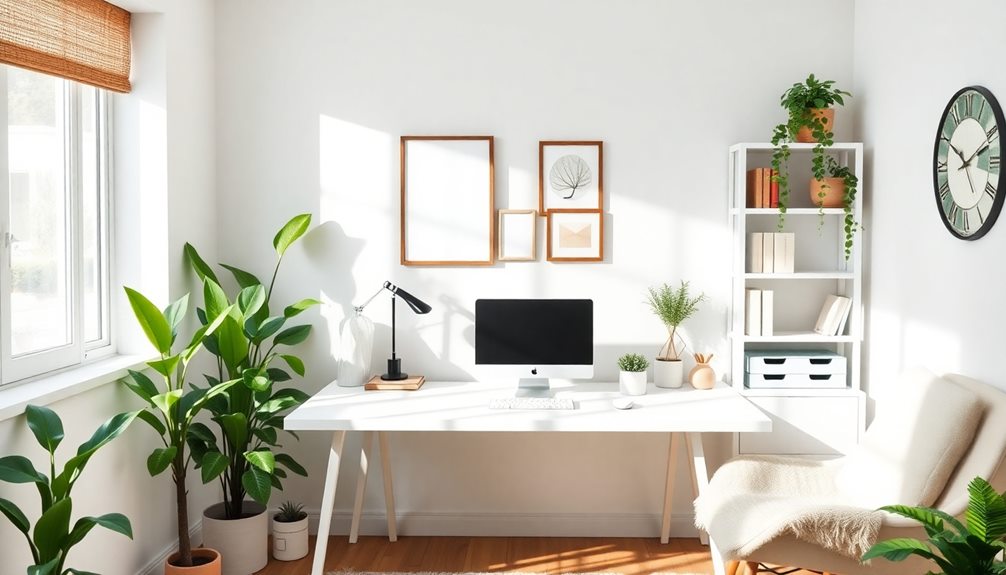
When you define your workspace aesthetic, you're not just choosing colors and furniture; you're creating an environment that can boost your productivity and spark creativity. Your home office space should reflect your personal style while guaranteeing it serves its purpose effectively.
Start by considering color schemes that evoke the right mood—calming blues or energizing yellows can make a difference. Additionally, incorporating elements from nature can enhance your workspace, as seen in creating a cohesive indoor-outdoor flow.
Next, think about the furniture you select. Ergonomic chairs and functional desks enhance comfort and efficiency, while unique pieces can add visual interest.
Lighting also plays a significant role; natural light can uplift your mood, while task lighting guarantees you can focus on your work without strain.
Don't forget to personalize your space with decor that resonates with you. Artwork, plants, or meaningful objects can create a positive emotional connection, making your workspace enjoyable.
Lastly, consider current trends like biophilic design and minimalism. Integrating nature and decluttering can improve your well-being and keep your home office space organized.
Importance of a Thoughtful Design

A thoughtful design in your home office can considerably enhance your productivity levels by minimizing distractions and fostering focus.
Incorporating ergonomic furniture and natural lighting are key elements that contribute to a comfortable and efficient workspace.
By reflecting your personal style through decor and layout, you create a space that inspires and motivates you to work efficiently.
Balancing functionality with aesthetics not only makes your workspace more enjoyable but also boosts your overall well-being.
Remote work productivity can greatly benefit from such an environment.
Enhancing Productivity Levels
Thoughtful design in your home office can considerably boost your productivity levels. A clutter-free environment allows you to focus better, potentially increasing your output by up to 20%. Organizing your office supplies not only enhances efficiency but also minimizes distractions, helping you stay on task.
Creating an Interior Design Mood Board can also inspire you to choose elements that resonate with your personal style and enhance your workspace.
Incorporating natural light is essential; it improves your mood and energy, making it easier to combat fatigue throughout the day. Position your desk near a window to maximize this effect, ensuring you benefit from those rays of sunshine.
Ergonomic furniture, like adjustable desks and supportive chairs, plays a significant role in your comfort. Reducing physical strain allows you to work for longer periods without discomfort, which directly contributes to your overall productivity.
Additionally, effective lighting solutions, such as warm bulbs and task lighting, create a cozy home office atmosphere that fosters relaxation. This balance of comfort and functionality can enhance your creativity and focus, making your workspace not just a place to work but an inspiring environment to thrive in.
Reflecting Personal Style
Designing a home office that reflects your personal style not only fosters a sense of belonging but also enhances your motivation to work. When you surround yourself with personal artifacts, like family photos, unique decor, and meaningful artwork, you create an emotional connection to your workspace. This connection can markedly boost your productivity levels.
Choose a cohesive color palette that aligns with your preferences. If you want to promote tranquility, consider blues; if you aim to spark creativity, yellows can do the trick. Incorporating elements like plants or your favorite books adds aesthetic value while contributing to your mental well-being, creating a calming atmosphere.
It's essential to integrate functional yet stylish furniture into your interior design. An ergonomic chair or a vintage desk not only provides comfort but also showcases your unique taste.
By carefully selecting these elements, you create a space that's visually pleasing and highly functional. Ultimately, a thoughtfully designed home office that mirrors your personal style can transform your work experience, making it more enjoyable and productive.
Embrace your individuality, and let your workspace reflect who you are!
Essential Elements for Aesthetic Spaces
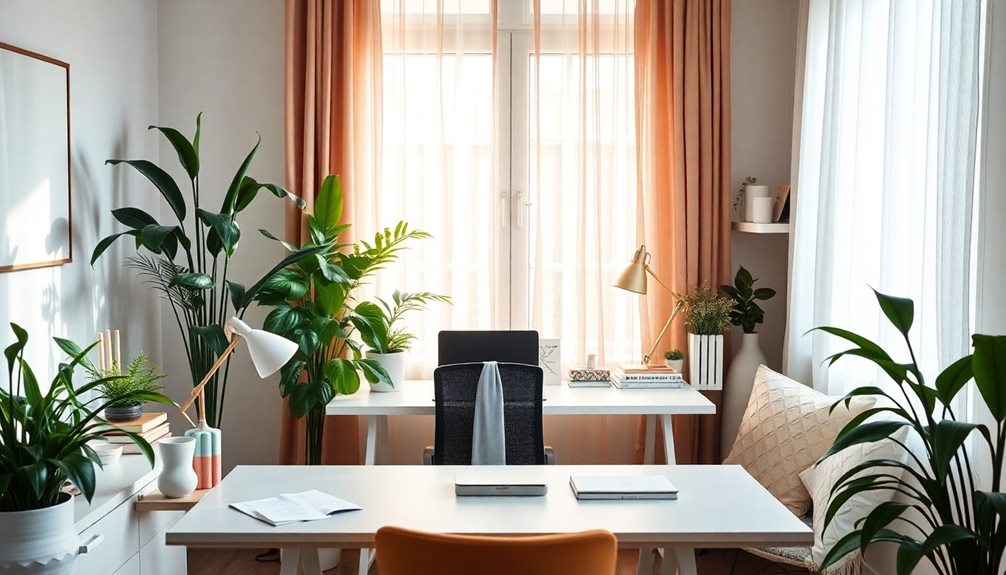
To create an aesthetic home office, start by choosing a cohesive color scheme that reflects your style and enhances your mood.
Next, select functional furniture that not only looks good but also supports your work needs.
Color Schemes and Patterns
Creating an aesthetic home office space hinges on the right color schemes and patterns. The colors you choose can dramatically impact your mood and productivity. Warmer tones like yellow and orange spark creativity, while cooler shades such as blue and green foster calmness and focus.
Here are some tips to help you select the perfect colors and patterns for your workspace:
- Use bold accent walls or vibrant wallpaper to add personality.
- Maintain color continuity with matching decor and furniture for harmony.
- Incorporate patterns like stripes or florals to create visual interest.
- Balance neutral colors with pops of color through accessories.
- Confirm your colors and patterns support a coherent theme.
Functional Furniture Selection
When you prioritize functional furniture selection, your home office can transform into a space that not only looks good but also supports your workflow.
Start by incorporating ergonomic furniture, like an adjustable chair and desk. This choice enhances comfort and posture, making those long hours of work much more manageable.
Next, consider multifunctional furniture, such as a desk with built-in storage. This helps keep your workspace organized and clutter-free, optimizing your limited space.
You can also opt for stylish yet functional pieces, like a sleek bookshelf or decorative storage boxes, which elevate the aesthetic of your office while providing practical storage solutions.
Make sure your desk complements the overall design theme, whether minimalist, rustic, or modern. This cohesion enhances the visual appeal of your workspace.
Natural Light Integration
Natural light is a powerful element in designing an aesthetic home office that boosts both mood and productivity.
When you're working from home, integrating natural light can transform your workspace into a vibrant environment.
Here are some home office ideas to maximize that sunlight:
- Position your desk near windows or in a corner to soak up the most natural light.
- Use sheer window treatments to diffuse harsh sunlight while letting in ample daylight.
- Strategically place mirrors to reflect natural light and create a more spacious feel.
- Incorporate plants that thrive in natural light, such as succulents or snake plants, for both aesthetic appeal and improved air quality.
- Consider light-colored walls and furniture to enhance brightness and make the space feel airy.
Current Trends in Home Offices
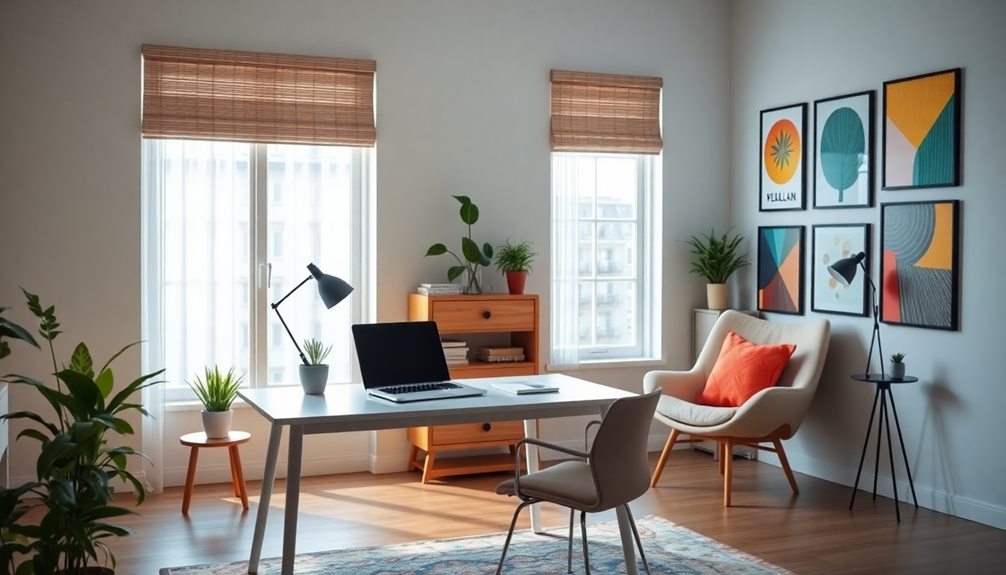
Home offices are evolving rapidly, reflecting the changing needs of remote workers. One of the most popular home office ideas today is biophilic design, which focuses on integrating natural elements like plants and light to boost your well-being and productivity.
Minimalist aesthetics also dominate, promoting clutter-free spaces with neutral colors and functional furniture that prioritize simplicity.
As you spend more time working from home, investing in ergonomic furniture becomes vital. Adjustable desks and supportive chairs help guarantee comfort during long hours.
Additionally, flexible workspaces are gaining traction, allowing you to adapt your environment for various tasks. Multifunctional furniture that can easily shift from work to leisure is a game-changer.
Sustainable materials and eco-friendly decor choices are now significant trends, reflecting a growing awareness of environmental impacts.
By choosing items made from recycled or responsibly sourced materials, you not only create a healthier workspace but also contribute positively to the planet.
Embracing these current trends will help you design a home office that's not only functional but also aligned with your values and lifestyle.
Tips for Personalized Decor

Often, personalizing your home office decor can transform it into a space that truly reflects who you are. By incorporating elements that resonate with you, you create an inviting environment that boosts your creativity and motivation.
Here are some tips to get started:
- Display personal artifacts like family photos and travel souvenirs.
- Choose a color palette that inspires you and enhances your mood.
- Add art pieces that motivate, such as abstract face art posters.
- Use decorative organizers, like stylish baskets or unique desk accessories.
- Regularly update your decor with seasonal finds to keep the space invigorating.
Start by selecting personal artifacts that showcase your experiences and personality. A carefully chosen color palette can set the mood—pick hues that energize or calm you, depending on your needs.
Integrate art that inspires confidence and positivity. Don't forget functional yet aesthetically pleasing decorative organizers; they'll help keep your workspace tidy while enhancing its appeal.
Creating a Productive Atmosphere
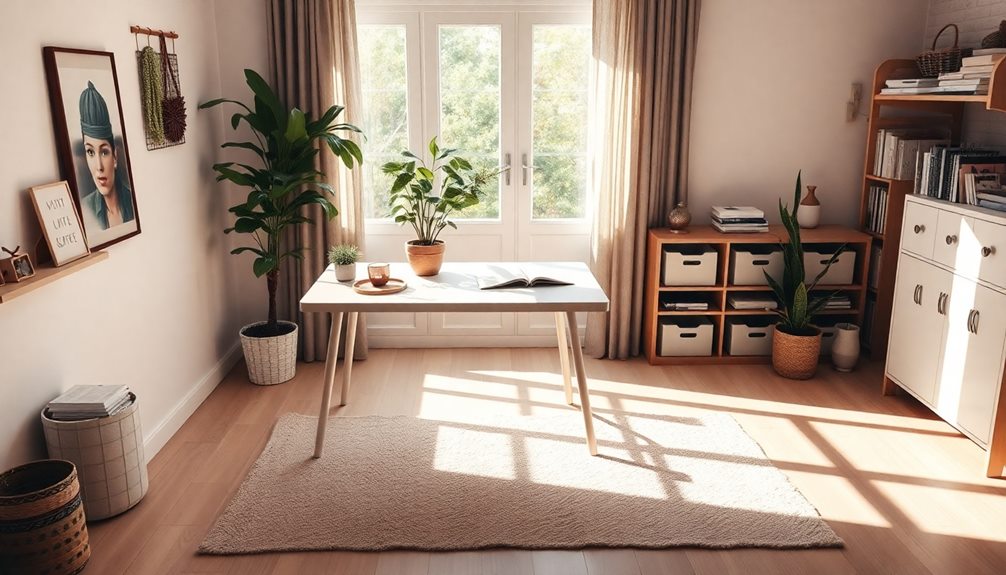
To foster a productive atmosphere in your office, focus on the essentials that enhance your workflow and well-being. Start by ensuring your workspace is well-lit, combining natural light with task lighting. This can boost productivity by up to 20% and reduce eye strain during long hours.
Next, choose the perfect desk chair that provides comfort and support, allowing you to focus without distractions.
Incorporate plants into your home office; they improve air quality and can elevate your mood by 15%. Personalizing your space with decor that reflects your style creates a positive emotional connection, enhancing motivation.
Organize your desk with labeled containers and clear storage solutions to reduce clutter, which can lead to a 30% increase in efficiency.
Consider the color palette of your office items as well. Colors that resonate with you can influence mood and energy levels, increasing creativity and focus by up to 25%.
Frequently Asked Questions
How to Make Your Office Aesthetically Pleasing?
To make your office aesthetically pleasing, choose a cohesive color palette, add natural elements like plants, select stylish furniture, incorporate personalized decor, and utilize effective lighting to create a comfortable and inspiring work environment.
How Can I Make My Home Office Pretty?
You can make your home office pretty by choosing a cohesive color palette, adding personal decor, incorporating greenery, selecting stylish storage solutions, and enhancing lighting. These elements together create an inviting and inspiring workspace.
How Do I Create a Minimalist Home Office?
To create a minimalist home office, start with a neutral color palette, choose multifunctional furniture, and incorporate minimal decor. Keep your workspace tidy by decluttering regularly, promoting focus and enhancing productivity in your environment.
How Do I Design a Home Office Layout?
To design your home office layout, measure your space first. Position your desk near a window for natural light, ensuring ergonomic placement of your computer. Utilize vertical storage to keep the area organized and efficient.
Conclusion
In crafting your aesthetic home office, remember that the devil's in the details. By thoughtfully defining your workspace, embracing current trends, and adding personal touches, you can create an environment that not only looks good but also boosts your productivity. Don't hesitate to experiment and let your creativity flow; after all, this is your sanctuary. With the right elements in place, you'll be well on your way to achieving a harmonious and inspiring workspace.
Xavier – Your Operations Partner Xavier is your operations partner, working tirelessly behind the scenes to ensure that everything runs smoothly so you can enjoy a seamless experience with Perfect Fit Living. From managing inventory to coordinating logistics, he’s committed to making your experience with us hassle-free.
-

 Vetted5 months ago
Vetted5 months ago14 Best Personalized Father's Day Gifts for Your Husband – Show Him You Care
-

 Alfresco5 months ago
Alfresco5 months agoAlfresco Stacker Doors: Seamless Indoor-Outdoor Living!
-

 Vetted6 months ago
Vetted6 months ago15 Best EMS Foot Massagers for Neuropathy to Soothe Your Feet
-

 Craft and Textiles7 months ago
Craft and Textiles7 months ago15 Best Places to Buy Appliances for Your Home – Top Retailers Reviewed
-

 Vetted5 months ago
Vetted5 months agoBattle Born Batteries Review: Reliable Power Solution
-

 Vetted5 months ago
Vetted5 months agoD-Link Switch Review: Lite Layer 3 Managed Networking
-
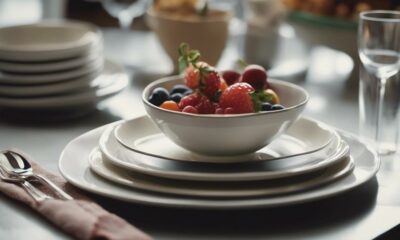
 Tableware and Dining Accessories7 months ago
Tableware and Dining Accessories7 months agoWhat Is the Meaning of the Word Tableware
-

 Tableware and Dining Accessories7 months ago
Tableware and Dining Accessories7 months agoWhen Is Tableware on Sale at Hobby Lobby
























